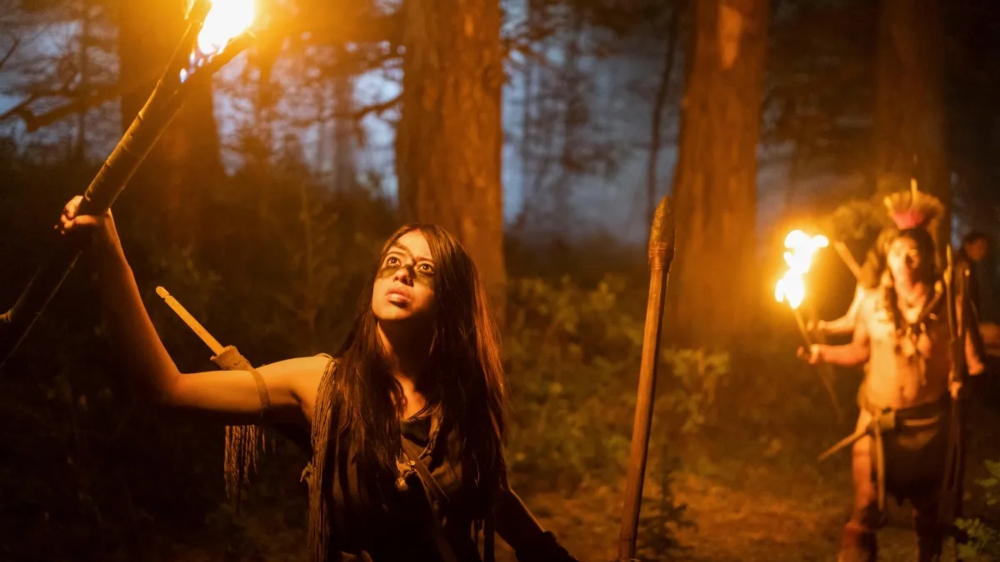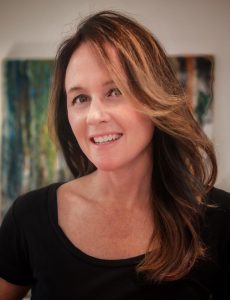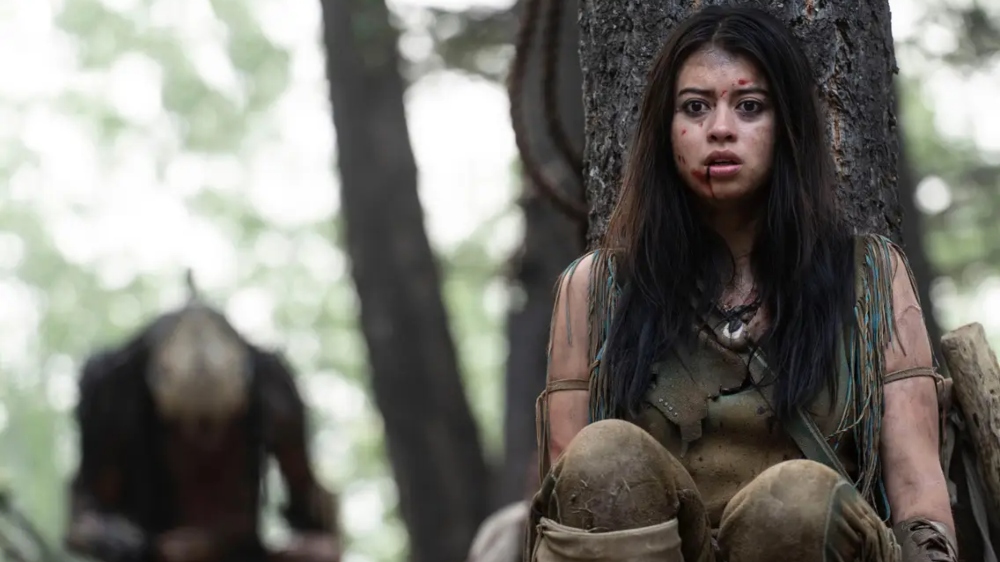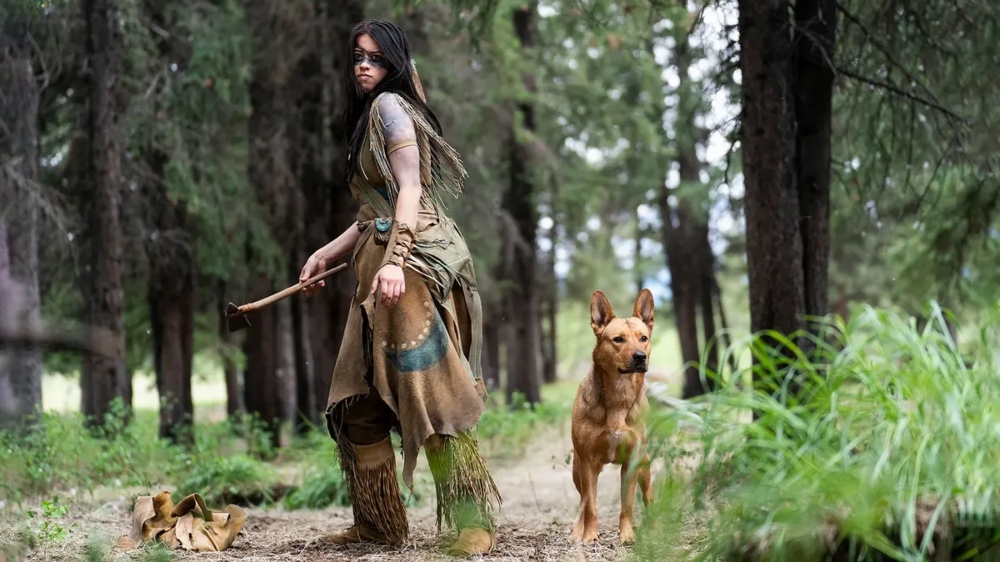
Prey is exemplary cleanliness. As far as an action-adventure goes, it doesn’t waste its time, but it doesn’t rush the characters or story, either. Director Dan Trachternberg and his team of editors, Angela M. Catanzaro and Claudia S. Castello, crafted a deeply satisfying experience with the Predator prequel.
As a result, in addition to all the love from audiences and critics, Catanzaro and Castello received an Emmy Nomination for Outstanding Picture Editing For A Limited Or Anthology Series Or Movie.
The word outstanding fits, given Catanzaro has a crystal clear eye for action. Previously, she cut one of Jackie Chan‘s finest 21st century films, The Foreigner, and also delivered good fun with director Martin Campbell’s The Protege. Recently, the Emmy nominee spoke to Below the Line about her firm grasp of telling stories through action.

Below-the-Line: Prey is so lean and has so much momentum, but at the same time, delivers moments of intimacy. How did you strike that balance with Claudia?
Angela M. Catanzaro: Of course, it was a lot of watching the movie and a lot of feedback from our audiences, but really, a lot of that was built in directly into the script. Patrick Aison did an amazing job, and with Dan’s help, I mean, the script was great, but as we were cutting, we knew that yes, this is an action movie. It’s a franchise film, so it has to be satisfying for people who want to see the predator. They want to see him kicking ass, but we needed to make space for those emotional moments so that the audience will care about our characters.
It really was quite a balancing act. But every scene, of course, we evaluate individually and never want to overstay our welcome. A lot of the work that we did was really pairing things down to the minimum amount we can do with dialogue and still convey the message.
Sometimes we found that the less we did in terms of dialogue, the more effective the scene would be. It did also really help with the pace just naturally because we were able to excise some of the words that were doing work for us, but not enough to warrant being in the movie when we could essentially achieve the same thing with just the visuals and the sound. And the sound design is critical to all of that working without the dialogue.
It was a balancing act and we cut right up until the end, even during the final mix, we were still making changes. Our poor sound team the last day on the stage, we came in and we had, I think the day we were print mastering, we even had a change, and of course felt horribly about it, but it was something that Dan felt strongly about.
And so, we made the change, but it was literally ripped away from us because we were so concerned with just always having exactly the right balance, the right scenes in the right order. So yeah, we did a ton of experimentation and a lot of it with a lot of editing. It’s just trial and error and seeing what works, and you really do have to then watch the film front to back to know if it works. So it’s pretty time consuming, but all of those exercises are really critical to achieving what we hope is the best version of the film. I mean, that’s always the goal.
BTL: Whenever I interview editors for monster movies, they always say there’s debate about when exactly to reveal the creature. How was that discussion on Prey?
Catanzaro: Well, in terms of are they staying true to the world that’s already been established for Predator, the language that’s been established and knowing how big the fan base for this movie is, it was tricky to keep an eye on making sure that it was satisfying for those fans, but that also it wouldn’t be alienating to people who were new to the predator world. I will admit, I am one of those people. So initially I was much more invested in Naru, and I was like, well, I love seeing her out in the wilderness, and I love seeing her flexing her warrior skills and how smart she is and her relationship with the land.
Early on, in fact, the studio suggested, and they were absolutely right, that we needed to get the predator in there a little bit more quickly. We did add three or four scenes, some of which were products of reshoots, and then one of which the scene where we actually first see the predator in the foam was just totally created out of nothing. We had a still plate of a vista and a mountain and predator rises into the frame, and that’s a fully CG predator that was created by visual effects to introduce him in that moment, because we did feel ultimately it was a little too long before we got to see a glimpse of him. But then you have to be careful not giving away too much. So he’s revealed fully until we meet him later.
I think the bear encounter is the first time we really get to see him in all of his glory. You do see him full body, but he’s silhouetted in the cave, and we wanted to establish the cloaking mechanism. So in that cave to introduce that to people who are new, this is how his cloak functions. This is something he can do, but not wanting to give away too much, wanting to keep people hungry for more and seeing what he’s all about.

BTL: And still let the main character experience the monster through their eyes?
Catanzaro: Yeah, absolutely. And Naru, she doesn’t know anything about him, so I like to keep their tracks sort of parallel. He doesn’t really know anything about her and she doesn’t know anything about him. They’re both on this exploratory journey, and that’s also something that we did experiment with a lot in editorial. How much should he know about her? How close should he be to her?
We had a lot of elements that we were able to really play with to adjust that to see what version of cat and mouse worked best for us, and to decide how close we wanted him to be on her trail. A lot of that was the intercutting, like the scene where she discovers the buffalo, then he discovers the buffalo, and we did play with proximity there.
In fact, the scene where she is trapped in the mud pit, there’s a cut in there now. That’s two pieces that originally were one piece, but we cut away to predator so that we could establish that he’s getting closer to her. So, we were pretty mindful of keeping that tension up all of the time, and anytime we had an opportunity to do something like that, we made sure that it was in the film.
BTL: The original is just a stunning example of clarity. How’d its sense of geography and pace influence you all?
Catanzaro: Well, Dan, he’s a huge fan of the original, and I think he’s just a fantastic director in that there’s not a lot of trickery in the way he shoots things. For me too, that’s part of why action sequences are so satisfying. It’s when you have a clear geography and you can really see the impact of the punches, the kicks, all of the stunts. For some of the big sequences, we did have pre-vis and we had stunt vis, and we had incredible stunt performers.
But with Amber, she did a lot of that work herself, and she was so physically capable and willing to do it that you don’t have to cut away. You do sometimes when you’re cutting action and you see it like, well, we’ll just have to do a whip pan here because nobody ever made contact with a punch, or we didn’t have a shot that looked like anyone made contact.
Trickery is the wrong word, but we were able to stay with some of the shots a little bit longer. And then in terms of the way they shot the action, they were very precise about certain things, and it certainly made my job easier. I was very pleased to see that because that’s one thing I really love when I’m able to follow the action, and it’s so much more impactful. I wish more directors would be mindful of that. It’s just not enough to see a whooshing camera. And yes, sound design is super important, but to me that’s not enough. It’s really cheating. There was very little cheating on this.
BTL: Amber’s performance is fantastic in the movie. When you and Claudia started editing her performance, what did you really want to maintain and focus on?
Catanzaro: She’s tremendous. She’s really so dedicated and such a force and so professional. She’s almost in every scene, obviously. There was never a moment in the dailies where I was like, well, she just kind of gave up. Never a moment, even with really long days on some very, very difficult, difficult scenes and just the physicality of it. I mean, I was exhausted watching all the things that she has to do, but some of the more emotional scenes, I know for any actor, those take a toll, and you could really tell she really brought it.
The scene where she’s washing her hands in the river and crying after her [brother] Taabe’s death, there were some other components to the scene. Like her dog comes in and she has a few words with her dog, and then she sits back, and we decided that to leave those out because what she was doing with her hands in the river at that moment was so, I mean, it was a very profound action, but it also just emotionally was very, it had an impact on me when I watched it.
It’s about Amber, but then we were able to intercut that with the scene of her mom getting the news about TA’s death. It was interesting to see when we did that, the parallels in their physicality and their reactions to taking in and digesting the same news. She had such a tremendous range of motion and emotion.
BTL: Do you also just find a great performance like that that helps with pacing?
Catanzaro: I think so much of as editors, so much of what we do is try to cover up and hide and conceal and cut away, and there are always going to be cheats. We’re always going to reach in deep into our toolkit for certain moments. But I didn’t have to fight with anything in this film. I didn’t have to fight with any of the footage. We did some pretty crazy things and explored a lot of different ways to use the material, but it was truly like an exploration. It wasn’t like, how are we going to solve this problem? Because somebody in the cast didn’t bring it for us. Everybody brought it.

BTL: I enjoyed that this movie just opens with nature to pull audiences in. You hear stories of streamers telling filmmakers something big to happen in the first scene. Was that always the opening?
Catanzaro: I mean, pretty soon thereafter, you’re going to be bombarded with enough. I like it. Also, throughout the movie, we do a lot of juxtaposing these crazy big sounds and score events with just the quiet of the forest and the birds and the forest. I really enjoyed all the backgrounds and the textures that were in the forest. So throughout we do try to recenter the audience and give ’em a moment to breathe before we launch into the next thing.
But yeah, I thought that was a cool way to start. I don’t remember who came up with the voiceover because that was not scripted, but that came up later while we were cutting. So that was a new addition, but everybody really, really liked it.
BTL: By the way, that’s high praise you have for Amber as far as the action goes considering you’ve edited Jackie Chan and Maggie Q performances.
Catanzaro: Yeah, no, she’s definitely got skills. I’ve been pretty lucky to have worked cutting some of the greats. I mean, yeah, Jackie Chan included.
BTL: Working on The Foreigner and cutting Jackie Chan action sequences, is that a big learning experience?
Catanzaro: Yeah. Well, the way that Jackie works in conjunction with the way that Martin [Campbell] shoots really taught me about the importance of precision and clarity. I got spoiled right out of the gate by both of them because Jackie is very precise. Everything is rehearsed to a T and there’s counts and he has a rhythm and everybody in the scene with him better beyond it, or you’ll be going again until you get it right.
Jackie wants to be able to complete an entire series of actions without having to cut away. He designs the scenes, and his stunt team too, so that he can go all the way through and the editor doesn’t need to cut. Of course, that involves being really tight and very careful and just everybody on their marks all the time.
Martin shoots very much that way too. He doesn’t do a lot of long lenses. It has to be sharp, it has to be clear. Both of them together, I mean, that was a little bit of the perfect storm and spoiled me in terms of the material that I had. They set the bar pretty high too, because now I’m looking for exactly that kind of thing. Whenever I’m cutting action, I want every few shots to really orient the audience. I think the action is so much more impactful when the audience knows where they are.
The Emmy-nominated Prey is now available to stream on Hulu.





